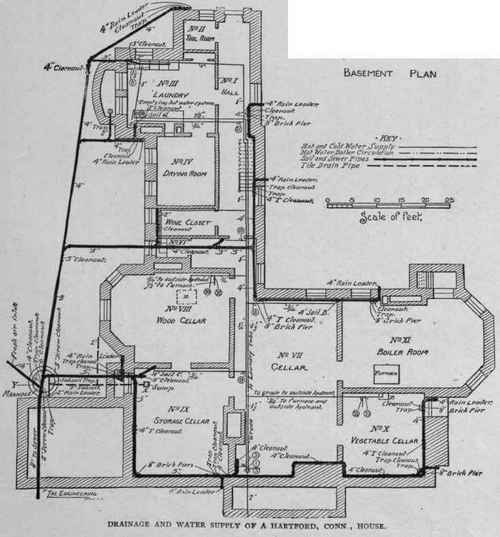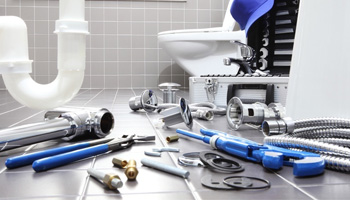The Core Parts of Your Home's Plumbing System
The Core Parts of Your Home's Plumbing System
Blog Article
What are your thoughts on Understanding Your Home's Plumbing Anatomy?

Recognizing how your home's plumbing system functions is essential for every house owner. From supplying tidy water for drinking, cooking, and showering to securely removing wastewater, a well-maintained pipes system is vital for your family's health and comfort. In this detailed overview, we'll explore the complex network that composes your home's plumbing and offer suggestions on upkeep, upgrades, and managing usual problems.
Introduction
Your home's pipes system is more than just a network of pipelines; it's a complex system that ensures you have accessibility to tidy water and efficient wastewater removal. Knowing its elements and just how they work together can help you stop costly repair services and make certain every little thing runs efficiently.
Basic Parts of a Pipes System
Pipelines and Tubes
At the heart of your pipes system are the pipes and tubing that carry water throughout your home. These can be made from different products such as copper, PVC, or PEX, each with its benefits in regards to durability and cost-effectiveness.
Fixtures: Sinks, Toilets, Showers, and so on.
Fixtures like sinks, toilets, showers, and bathtubs are where water is used in your home. Understanding how these fixtures connect to the pipes system aids in diagnosing troubles and intending upgrades.
Shutoffs and Shut-off Points
Valves manage the circulation of water in your plumbing system. Shut-off valves are critical during emergencies or when you require to make fixings, enabling you to isolate parts of the system without interrupting water flow to the whole residence.
Water Supply System
Key Water Line
The major water line attaches your home to the metropolitan supply of water or a personal well. It's where water enters your home and is distributed to various components.
Water Meter and Pressure Regulator
The water meter actions your water use, while a pressure regulatory authority makes sure that water flows at a secure stress throughout your home's pipes system, avoiding damage to pipelines and fixtures.
Cold Water vs. Warm water Lines
Recognizing the distinction between cold water lines, which provide water straight from the main, and warm water lines, which bring heated water from the hot water heater, aids in fixing and preparing for upgrades.
Drain System
Drain Pipes and Traps
Drain pipelines carry wastewater away from sinks, showers, and commodes to the drain or septic system. Catches avoid sewer gases from entering your home and likewise trap particles that might cause clogs.
Air flow Pipes
Air flow pipes permit air into the water drainage system, avoiding suction that could reduce drainage and cause catches to empty. Correct air flow is important for keeping the stability of your plumbing system.
Relevance of Appropriate Drain
Guaranteeing correct drainage protects against backups and water damages. Frequently cleaning drains and keeping traps can protect against expensive fixings and prolong the life of your plumbing system.
Water Heating Unit
Kinds Of Water Heaters
Water heaters can be tankless or typical tank-style. Tankless heaters warm water on demand, while storage tanks save heated water for instant usage.
Updating Your Plumbing System
Reasons for Updating
Upgrading to water-efficient components or replacing old pipelines can improve water high quality, minimize water costs, and increase the worth of your home.
Modern Plumbing Technologies and Their Benefits
Discover modern technologies like wise leakage detectors, water-saving commodes, and energy-efficient water heaters that can save cash and lower environmental effect.
Cost Factors To Consider and ROI
Compute the upfront expenses versus lasting savings when thinking about pipes upgrades. Many upgrades pay for themselves via reduced utility bills and fewer repair services.
Just How Water Heaters Connect to the Plumbing System
Recognizing how hot water heater connect to both the cold water supply and warm water distribution lines aids in diagnosing concerns like insufficient hot water or leakages.
Upkeep Tips for Water Heaters
Routinely flushing your water heater to eliminate debris, examining the temperature settings, and examining for leaks can extend its life expectancy and enhance power performance.
Usual Plumbing Issues
Leaks and Their Causes
Leakages can take place due to aging pipes, loose installations, or high water stress. Attending to leakages immediately stops water damages and mold and mildew development.
Clogs and Blockages
Obstructions in drains pipes and toilets are usually brought on by purging non-flushable products or an accumulation of oil and hair. Using drain screens and being mindful of what goes down your drains pipes can protect against obstructions.
Indicators of Pipes Issues to Look For
Low water pressure, slow-moving drains pipes, foul odors, or abnormally high water costs are signs of potential pipes troubles that must be addressed without delay.
Plumbing Maintenance Tips
Normal Assessments and Checks
Schedule annual plumbing inspections to capture concerns early. Search for indications of leaks, corrosion, or mineral build-up in faucets and showerheads.
DIY Upkeep Tasks
Basic tasks like cleaning tap aerators, looking for bathroom leaks using color tablets, or insulating exposed pipelines in chilly climates can prevent significant plumbing concerns.
When to Call a Specialist Plumbing
Know when a plumbing issue calls for expert proficiency. Attempting intricate repair services without proper knowledge can bring about even more damage and greater repair service costs.
Tips for Lowering Water Usage
Basic habits like repairing leaks immediately, taking shorter showers, and running complete tons of washing and meals can conserve water and reduced your energy expenses.
Eco-Friendly Pipes Options
Consider lasting plumbing products like bamboo for floor covering, which is durable and eco-friendly, or recycled glass for counter tops.
Emergency Readiness
Actions to Take During a Plumbing Emergency situation
Know where your shut-off shutoffs are located and just how to turn off the water system in case of a burst pipeline or major leak.
Importance of Having Emergency Situation Contacts Convenient
Keep get in touch with information for local plumbing technicians or emergency situation services easily offered for quick feedback throughout a pipes dilemma.
Ecological Impact and Preservation
Water-Saving Components and Home Appliances
Mounting low-flow faucets, showerheads, and bathrooms can dramatically decrease water usage without giving up efficiency.
DIY Emergency Situation Fixes (When Applicable).
Momentary solutions like using air duct tape to spot a leaking pipeline or positioning a container under a trickling faucet can reduce damages till an expert plumber shows up.
Verdict.
Recognizing the composition of your home's plumbing system encourages you to maintain it properly, saving money and time on fixings. By following regular maintenance regimens and remaining informed regarding modern-day plumbing innovations, you can guarantee your pipes system operates efficiently for many years ahead.
HOW YOUR PLUMBING SYSTEM WORKS
Which Pipes Do What?
Blue lines = fresh water supply entering the building Red lines = hot water supply entering the building Grey lines = pipes carrying waste away from the building and venting pipes carrying gases away from the building (through the roof) YOUR MAIN PLUMBING SYSTEMS
There are two main plumbing systems that support your home s basic plumbing needs one that brings clean water into your home, and one that sends dirty water away from your home. Connected to the toilet, bath, shower, and other faucets in your home, these two systems keep your water flowing in the right directions.
ACCESSING FRESH WATER
Fresh and clean water is brought into your home through the main water supply line . Filtered through one pipe, this water is pressured to flow into the various fixtures in your home at any given time.
This water can be sourced from a well located on your property, a pond or river (mostly cottages), or, as in most cases, from the city s municipal water treatment centre. However, it is important to note that water that is untreated, such as the water siphoned from ponds or rivers, may not be safe to drink. Personal water supplies always need to be treated for hardness and contaminants before consumed.
MUNICIPAL WATER SUPPLIES
Improve taste and odour Remove sediment Eliminate hardness Reduce chlorine COLD WATER SUPPLY VS. HOT WATER SUPPLY
Cold water flows into your home or building through the service line, which then distributes hot or cold water to your fixtures. This line is most commonly run through a central column that runs floor to floor. Hot water runs in short and straight pipes as the longer the pipeline, the more heat that will be lost in the transfer. Having shorter pipes also allows residents to access hot water more quickly.
WASTE WATER SYSTEM
Your wastewater system is divided into two parts pipes that send wastewater away from your home and venting pipes that send sewer gas away from your home. Sewage water travels through pipes that flush the water and waste towards local sewers that are operated and managed by your city or town. Most sewer systems rely on gravity to move the wastewater to where it needs to go.
The further away from your toilet or sink, the larger wastewater pipes become. This allows for waste to be disposed of from various parts of your home or business at once without pipe blockages. The angle and flow of these pipes are also essential for keeping your waste pipes clear of build up.
https://harrisplumbing.ca/how-your-home-plumbing-system-works/

We had been guided to that article on Plumbing Installation 101: All You Need to Know through a buddy on our other blog. Liked our review? Please quickly share it. Help somebody else discover it. We take joy in your readership.
Call Today Report this page